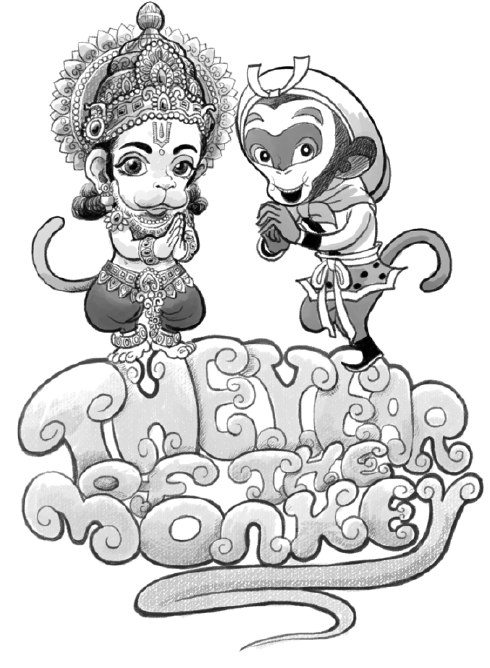Year of the Monkey connects China and India
Updated: 2016-02-04 08:31
By Swaran Singh(China Daily)
|
||||||||
 |
| LUO JIE/CHINA DAILY |
China is not alone in preparing to celebrate the Year of Monkey.
China's "Monkey King" symbolizes a deeper cultural connection with its biggest neighbor, India. India is not just home to the world's largest number of monkeys but also has a monkey god, Hanuman, as the central character of one of its mythological stories and part of everyday cultural narrative.
The Year of the Monkey should, therefore, offer China and India more avenues to address the arduous task of deepening mutual understanding and trust. For instance, the two neighbors signed a memorandum of understanding on co-producing films during Indian Prime Minister Narendra Modi's visit to Beijing in May 2015 and Xuanzang was their priority project. The film is scheduled for a joint release to celebrate the Lunar New Year.
Xuanzang, the famous Tang Dynasty (618-907) monk, returned from a 17-year pilgrimage to India in 629 AD with 657 volumes of Buddhist scripture. His pilgrimage was first fictionalized as Journey to the West during the Ming Dynasty (1368-1644) marking the revival of consciousness about the ancient Silk Road connecting China with India. In the Journey to the West, Sun Wukong, or the Monkey King, protects Xuanzang during his journey to India along with three other characters, Zhu Wuneng (or Zhu Bajie) the Pig, Sha Wujing (or Sandy) and Bailong, a dragon prince who acts as Xuanzang's steed, a white horse.
The monkey does not just rank 9th in the 12-animal Chinese Zodiac but also is a prominent symbol in the lore and arts of various Asian religions, including Buddhism and Hinduism. Experts, from Glen Dudbridge to Wolfgang Mieder, have been debating whether China's mythical character Sun Wukong was inspired by Hanuman of the Indian mythological epic Ramayana. While these debates remain inconclusive, the two monkeys have evolved into very distinct popular characters. And there is no denying their close cultural connections.
The Journey to the West and Ramayana both have been made into many films, TV serials, animations and operas, making the Monkey King a venerated figure even for younger generations. This provides the two neighbors an important constituency that should represent a combined symbol of rising China and India-a monkey is surely benign compared to a dragon (a popular symbol of China) and agile compared to an elephant (which symbolizes India).
In his book, Views on India, China and on the Shores of Red Sea, published in 1835, Robert Elliott talks about of how he was startled to see monkeys, despite their value, being worshiped in India and how "two young (British) officers who fired at a monkey were drowned in the Jamuna (river), in the vain attempt to escape from the range of an exasperated multitude pursuing them to their destruction".
Things are no different today and killing a monkey is still not seen as a solution to the monkey problem in urban or rural India. And as the Chinese version of monkey goes global with preparations for grandiose and colorful celebrations in China and overseas, it can also become another symbol of China's cultural connection with the rest of Asia. Hence, the monkey can become one of the many elements helping China and India come closer.
The author is a professor at the School of International Studies, Jawaharlal Nehru University, New Delhi.
- Global health entering new era: WHO chief
- Brazil's planning minister steps aside after recordings revelation
- Vietnam, US adopt joint statement on advancing comprehensive partnership
- European border closures 'inhumane': UN refugee agency
- Japan's foreign minister calls A-bombings extremely regrettable
- Fukushima impact unprecedented for oceans: US expert

 Stars of Lijiang River: Elderly brothers with white beards
Stars of Lijiang River: Elderly brothers with white beards
 Wealthy Chinese children paying money to learn British manners
Wealthy Chinese children paying money to learn British manners
 Military-style wedding: Fighter jets, grooms in dashing uniforms
Military-style wedding: Fighter jets, grooms in dashing uniforms
 Striking photos around the world: May 16 - May 22
Striking photos around the world: May 16 - May 22
 Robots help elderly in nursing home in east China
Robots help elderly in nursing home in east China
 Hanging in the air: Chongqing holds rescue drill
Hanging in the air: Chongqing holds rescue drill
 2.1-ton tofu finishes in two hours in central China
2.1-ton tofu finishes in two hours in central China
 Six things you may not know about Grain Buds
Six things you may not know about Grain Buds
Most Viewed
Editor's Picks

|

|

|

|

|

|
Today's Top News
Liang avoids jail in shooting death
China's finance minister addresses ratings downgrade
Duke alumni visit Chinese Embassy
Marriott unlikely to top Anbang offer for Starwood: Observers
Chinese biopharma debuts on Nasdaq
What ends Jeb Bush's White House hopes
Investigation for Nicolas's campaign
Will US-ASEAN meeting be good for region?
US Weekly

|

|








